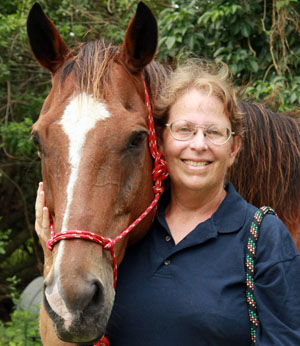TALES FROM THE TRAILS
On Monday, March 6, a handful of people gathered in the meeting room of the Wellington branch library to learn how planting and preserving native plants can benefit people, horses and the environment.
The program was funded and sponsored by the University of Florida/Palm Beach County Cooperative Extension Service and the Palm Beach County Department of Environmental Resources Management. It was presented by Adrienne Deutsch, program assistant for the Native Canopy Education Program.
Adrienne is also an experienced and accomplished dressage rider. It was her first time presenting the program. “Anxious? Me? No, I’m always a soprano,” she joked. “Honestly, I’d rather ride a Grand Prix test on a Shetland pony.”
She shouldn’t have worried. It progressed smoothly, a thoughtful PowerPoint presentation illustrating and depicting all of the plants. The unique thrust of this program was its focus on how planting and maintaining native canopy vegetation can benefit horses and horse owners.
“I want horse owners to, first, learn to appreciate, plant and preserve native canopy plants and, second, become aware of which plants are toxic or dangerous to horses and should be kept off or removed from their properties,” Adrienne said. “Mainly, I want people to come to recognize and sustain our beautiful, worthwhile canopy growth. Preserve, protect and restore native trees.”
The program began at 6:30 p.m. with a short introduction by Laurie Albrecht, environmental horticulture extension agent with the UF/Palm Beach County Cooperative Extension.
“Our area is losing large tracts of native land to development, especially the western parts of Palm Beach County,” she said. “It can be costly to the environment if we remove too much.”
Then Adrienne began her talk, explaining that “native” means something which was growing here when the first Europeans arrived. “Canopy” means upper-level tree cover (in other words, trees) as opposed to midlevel (shrubs and bushes) and low-level (grasses, groundcover). All three are necessary to provide wildlife with adequate food, shelter, places to raise their young, and protection from predators.
Her slides depicted horse properties with and without trees, and what became clear was how much horses like trees — especially here in South Florida. One slide showed a 20-degree difference in the same area, one sunny, one shaded. Slide after slide: horses under trees.
There were suggestions of how and where to plant trees to shade paddocks, pastures, fence lines, walking and bridle paths, wash racks, round pens and barns.
“Trees add property value, lower utility costs, act as barriers to road dust and noise, decrease water runoff, and can act as a privacy screen,” Adrienne explained. “Plus, they’re beautiful and colorful.”
The trick is planting the right tree in the right place, so it gets the proper amount of sun and rain, and has compatible soil. Once established and properly sited, native plants are low-maintenance.
“Good trees near a wetter area, like a wash rack, are bald cypress, pond cypress, sweetbay magnolia, wild coffee and cocoplum shrubs,” she said, showing pictures of each one. “Trees with high drought tolerance, for drier areas, include live oak, slash pine, sabal palm, buttonwood, and hedges or shrubs like American beauty berry, Jamaican caper, Simpson’s stopper and dune sunflower.”
Other safety considerations for equestrian properties are trees without extensive root systems, such as ficus and mahogany, which can damage hooves; trees which drop hard nuts; and toxicity.
“Some plants are fatal,” Adrienne said. “They kill horses. Examples are oleander, any cherry trees, red maple, azalea and non-native lantana. Poisonous weeds include creeping indigo, and the red berries of the rosary pea and Brazilian pepper. Even if these grow near your property, branches can blow in, or horses can reach over or under to get at them. Gardeners can use blowers, and leaves or berries can land in hay or pasture.”
Denise Darata of Loxahatchee, who owns a Paso Fino gelding named Gitano, came to learn about the poisonous plants. “I want to be able to recognize the bad ones, and know more about the good native plants,” she said.
Josh Fleming, of Jupiter Farms, bought an overgrown property, which he plans to make into a horse boarding facility. “I want to learn which plants are good for the environment, not invasive or harmful to horses, and not too hard to maintain,” he said.
His father-in-law, Chris Bingham, used to own horses. He, too, was glad to learn more about beneficial native plants.
Sharon Paletti keeps her two horses, a Quarter Horse and Quarter/Arab mix, at her home in suburban Lake Worth. “I want to know which plants are best. I have two big turnout paddocks, and lots of weeds,” she said. “I’d like to plant healthier trees and shrubs. I’m one of those totally green people, no pun intended.”
There was ample time at the end for questions, and there were a lot of useful handouts, even one explaining how to kill Brazilian pepper trees. Each participant also received a voucher for two native plants free from any local native nursery.
If you know little about plants, bring suspicious branches to the Palm Beach County Cooperative Extension office at 531 N. Military Trail and ask a master gardener. Its hours are 8:30 a.m. top 4:30 p.m. Monday through Friday. For more info., call (561) 233-1750.
To learn more, visit http://discover.pbcgov.org/erm or http://discover.pbcgov.org/coextension.








